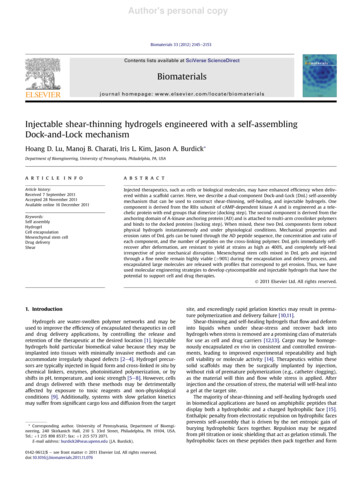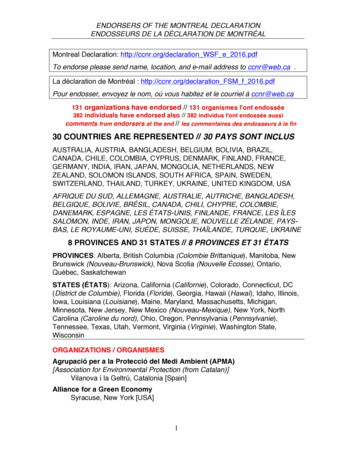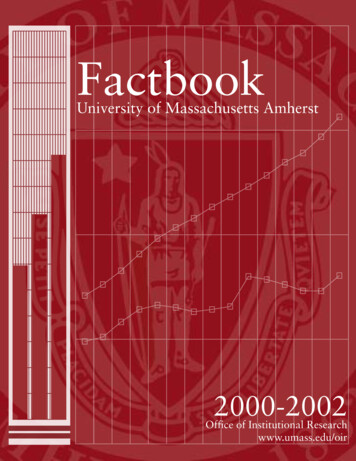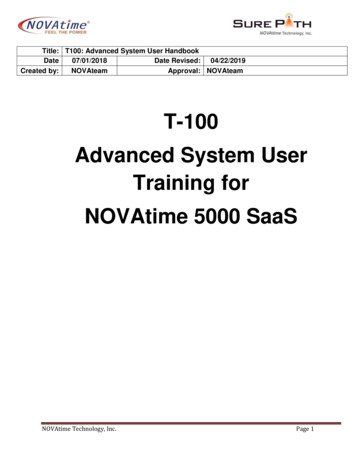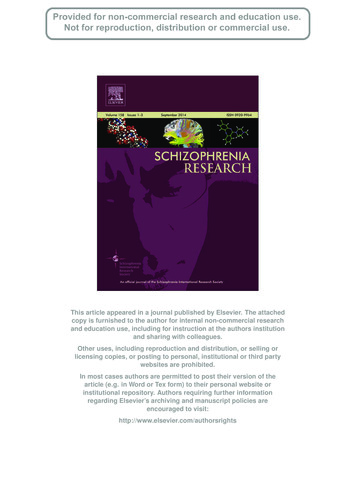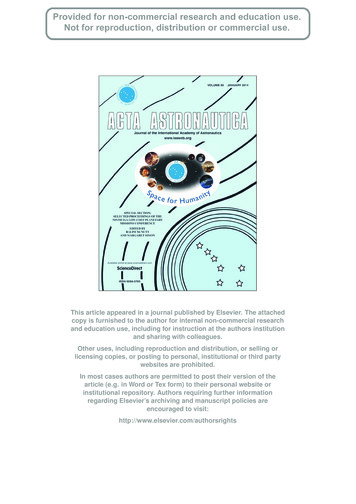
Transcription
This article appeared in a journal published by Elsevier. The attachedcopy is furnished to the author for internal non-commercial researchand education use, including for instruction at the authors institutionand sharing with colleagues.Other uses, including reproduction and distribution, or selling orlicensing copies, or posting to personal, institutional or third partywebsites are prohibited.In most cases authors are permitted to post their version of thearticle (e.g. in Word or Tex form) to their personal website orinstitutional repository. Authors requiring further informationregarding Elsevier’s archiving and manuscript policies areencouraged to visit:http://www.elsevier.com/authorsrights
Author's personal copyActa Astronautica 93 (2014) 509–515Contents lists available at ScienceDirectActa Astronauticajournal homepage: www.elsevier.com/locate/actaastroMESSENGER at Mercury: Early orbital operationsRalph L. McNutt Jr.a,n, Sean C. Solomon b, Peter D. Bedini a, Brian J. Anderson a,David T. Blewett a, Larry G. Evans c, Robert E. Gold a, Stamatios M. Krimigis a,d,Scott L. Murchie a, Larry R. Nittler b, Roger J. Phillips e, Louise M. Prockter a,James A. Slavin f, Maria T. Zuber g, Eric J. Finnegan a, David G. Grant a, theMESSENGER TeamaThe Johns Hopkins University Applied Physics Laboratory, Laurel, MD 20723, USADepartment of Terrestrial Magnetism, Carnegie Institution of Washington, Washington, DC 20015, USAcComputer Sciences Corporation, Lanham-Seabrook, MD 20706, USAdAcademy of Athens, Athens 11527, GreeceeSouthwest Research Institute, Boulder, CO 80302, USAfHeliophysics Science Division, NASA Goddard Space Flight Center, Greenbelt, MD 20771, USAgDepartment of Earth, Atmospheric and Planetary Sciences, MIT, Cambridge, MA 02129, USAba r t i c l e i n f oabstractArticle history:Received 11 January 2012Accepted 8 August 2012Available online 16 November 2012The MErcury Surface, Space ENvironment, GEochemistry, and Ranging (MESSENGER)spacecraft, launched in August 2004 under NASA’s Discovery Program, was inserted intoorbit about the planet Mercury in March 2011. MESSENGER’s three flybys of Mercury in2008–2009 marked the first spacecraft visits to the innermost planet since the Mariner10 flybys in 1974–1975. The unprecedented orbital operations are yielding new insightsinto the nature and evolution of Mercury. The scientific questions that frame theMESSENGER mission led to the mission measurement objectives to be achieved by theseven payload instruments and the radio science experiment. Interweaving the full setof required orbital observations in a manner that maximizes the opportunity to satisfyall mission objectives and yet meet stringent spacecraft pointing and thermal constraints was a complex optimization problem that was solved with a software tool thatsimulates science observations and tracks progress toward meeting each objective. Thefinal orbital observation plan, the outcome of that optimization process, meets allmission objectives. MESSENGER’s Mercury Dual Imaging System is acquiring a globalmonochromatic image mosaic at better than 90% coverage and at least 250 m averageresolution, a global color image mosaic at better than 90% coverage and at least 1 kmaverage resolution, and global stereo imaging at better than 80% coverage and at least250 m average resolution. Higher-resolution images are also being acquired of targetedareas. The elemental remote sensing instruments, including the Gamma-Ray andNeutron Spectrometer and the X-Ray Spectrometer, are being operated nearly continuously and will establish the average surface abundances of most major elements.The Visible and Infrared Spectrograph channel of MESSENGER’s Mercury Atmosphericand Surface Composition Spectrometer is acquiring a global map of spectral reflectancefrom 300 to 1450 nm wavelength at a range of incidence and emission angles. Targetedareas have been selected for spectral coverage into the ultraviolet with the Ultravioletand Visible Spectrometer (UVVS). MESSENGER’s Mercury Laser Altimeter is acquiringtopographic profiles when the slant range to Mercury’s surface is less than 1800 km,encompassing latitudes from 201S to the north pole. Topography over the remainder ofKeywords:MercuryMESSENGERPlanetary scienceOrbital missionsNASASurface compositionExosphereImpact basinsGravity fieldnCorresponding author. Tel.: þ1 443 778 5435; fax: þ1 443 778 0386.E-mail address: ralph.mcnutt@jhuapl.edu (R.L. McNutt Jr.).0094-5765/ - see front matter & 2012 IAA. Published by Elsevier Ltd. All rights 2.08.012
Author's personal copy510R.L. McNutt Jr. et al. / Acta Astronautica 93 (2014) 509–515the southern hemisphere will be derived from stereo imaging, radio occultations, and limbprofiles. MESSENGER’s radio science experiment is determining Mercury’s gravity fieldfrom Doppler signals acquired during frequent downlinks. MESSENGER’s Magnetometer ismeasuring the vector magnetic field both within Mercury’s magnetosphere and inMercury’s solar wind environment at an instrument sampling rate of up to 20 samples/s.The UVVS is determining the three-dimensional, time-dependent distribution of Mercury’sexospheric neutral and ionic species via their emission lines. During each spacecraft orbit,the Energetic Particle Spectrometer measures energetic electrons and ions, and the FastImaging Plasma Spectrometer measures the energies and mass per charge of thermalplasma components, both within Mercury’s magnetosphere and in Mercury’s solar-windenvironment. The primary mission observation sequence will continue for one Earth year,until March 2012. An extended mission, currently under discussion with NASA, would adda second year of orbital observations targeting a set of focused follow-on questions thatbuild on observations to date and take advantage of the more active Sun expected during2012–2013. MESSENGER’s total primary mission cost, projected at 446 M in real-yeardollars, is comparable to that of Mariner 10 after adjustment for inflation.& 2012 IAA. Published by Elsevier Ltd. All rights reserved.1. Introduction1.2. Accomplishments: discoveries from the Mercury flybys1.1. BackgroundIn addition to providing key gravity assists that enabledorbit insertion and opportunities to test science operationsand command sequences for all payload instruments,MESSENGER’s three flybys of Mercury yielded a numberof discoveries that changed our view of Mercury andinfluenced preparations for orbital operations.Regarding Mercury’s geological history, MESSENGERestablished that:The MErcury Surface, Space ENvironment, GEochemistry, and Ranging (MESSENGER) [1] spacecraft waslaunched in August 2004 [2] as the seventh mission inNASA’s Discovery Program. Following the trajectorydesign, MESSENGER completed six planetary flybys,including one of Earth, two of Venus [3], and three ofMercury [4]. The flybys enabled a full checkout of thescientific payload, and the data collected have led tosubstantial advances in understanding Mercury, beyondthe discoveries of Mariner 10.MESSENGER’s primary mission remains centered on 1year of orbital observations from a nominal 12-h orbit,initially with a periapsis altitude of 200 km, an inclinationof 82.51, and a periapsis latitude of 601N. These orbitalparameters were carefully chosen to comply with propellant and trajectory constraints, thermal and powerrequirements, and the science plan defined by the ProgramLevel Requirements (PLR) for the MESSENGER project.The MESSENGER spacecraft will accomplish its scientific investigations with its payload of seven scienceinstruments plus the telecommunication system for radioscience (RS) [5]. The instruments include the MercuryDual Imaging System (MDIS), which consists of an11-color-filter wide-angle camera (WAC) and a panchromatic narrow-angle camera (NAC) mounted on a singledegree-of-freedom scan platform [6]; a Gamma-Ray andNeutron Spectrometer (GRNS), including Gamma-RaySpectrometer (GRS) and Neutron Spectrometer (NS) sensors [7]; an X-Ray Spectrometer (XRS), including sensorsthat point at the planet and at the Sun [8]; a Magnetometer (MAG) [9]; the Mercury Laser Altimeter (MLA)[10]; the Mercury Atmospheric and Surface CompositionSpectrometer (MASCS), which uses a common telescopefor the Ultraviolet and Visible Spectrometer (UVVS) andthe Visible and Infrared Spectrograph (VIRS) [11]; andan Energetic Particle and Plasma Spectrometer (EPPS),consisting of the Energetic Particle Spectrometer (EPS)and the Fast Imaging Plasma Spectrometer (FIPS) [12]. Volcanism was widespread on Mercury and extended from before the end of heavy bombardment to thesecond half of solar system history [13–16].Mercury experienced pyroclastic volcanism, indicatingthat interior volatile contents were at least locallymuch higher than previously thought [13,17].Impact crater formation excavated material compositionally distinct from surrounding terrain, providing ameans to probe composition versus depth [18–20].Contraction spanned much of Mercury’s geologicalhistory [21–23].Large impact basins on Mercury were foci for concentrated magmatic activity and diverse styles of deformation [16,24,25].Regarding the composition of Mercury’s surface andsurface-derived exosphere, MESSENGER demonstratedthat: Mercury’s surface silicates, even in fresh crater ejecta,contain little or no FeO [26,27]. Mercury’s thermal neutron flux matches that of sev eral lunar maria, indicating that Fe and Ti are presentin comparable abundances, perhaps as oxides [28].Mg and Ca þ are present in Mercury’s exosphere [29,30].Mercury’s comet-like neutral tail contains multiplespecies [29–31].Mg, Ca, and Na have distinct distributions in the exosphere and tail, indicating species-dependent and timevariable source, transfer, and loss processes [29–32].
Author's personal copyR.L. McNutt Jr. et al. / Acta Astronautica 93 (2014) 509–515Regarding Mercury’s internal structure and dynamics,MESSENGER showed that: The equatorial topographic relief of Mercury, in agreement with earlier radar results, is at least 5.5 km [33]. Mercury’s long-wavelength equatorial topography is well fit by an ellipse aligned with the equatorialellipticity of the gravity field [34].The case for a liquid outer core on Mercury is greatlystrengthened [34].Mercury’s internal magnetic field is dominantly dipolarwith a vector moment closely aligned with the spin axis[35–37].Regarding magnetospheric dynamics at Mercury, MESSENGER established that: Mercury’s magnetosphere is more responsive to inter planetary magnetic field (IMF) fluctuations than thoseof other planets [38–40].Under southward IMF, rates of magnetic reconnectionare 10 times typical rates at Earth [39].Loading of magnetic flux from the dayside magnetosphere to the magnetotail and substorm-like unloading occur at timescales (minutes) much shorter than atEarth (hours), but no energetic particles have beenobserved to date [40].Loading can be so intense that much of Mercury’sdayside surface could be directly exposed to theshocked solar wind of the magnetosheath [40].511seasons, one long-eclipse season, and one short-eclipseseason. The long-eclipse seasons, when the ascendingnode of the orbit is in the planet’s shadow, are the moststressful to the spacecraft power and thermal systemsbecause, in addition to long-eclipse windows, the spacecraft passes at low altitude over the subsolar region of theplanet. The solar flux at Mercury is up to 11 times higherthan at Earth, so the spacecraft sunshade always faces theSun to within a 121 101 angular Sun-keep-in (SKI)boundary relative to the center of the sunshade. The backof the spacecraft is exposed to radiant heat from theplanet, but the elliptical orbit minimizes the time spent atlow altitudes over the hot planet and allows the spacecraft to re-radiate heat at high altitudes. Because one solarday at Mercury equals 176 Earth days, the 1-year primaryorbital mission spans only two Mercury solar days. Thesurface mapping observations were therefore pre-plannedfor the entire year to ensure coverage of the full planetunder optimized illumination and viewing geometries.The highest-priority imaging observations are scheduledfor the first solar day, so that any missed observations canbe recovered during the second solar day. Topography,surface composition, RS, exosphere, and magnetosphereobservation campaigns are coordinated to ensure thateach investigation acquires the data required for itsrespective objectives. The MDIS cameras are mountedon a pivot that provides freedom to view sunward andanti-sunward of the common instrument boresight direction, and the majority of the MDIS observations areacquired while spacecraft pointing is dedicated to one ofthe other instruments.2. Primary mission objectivesThe MESSENGER spacecraft is orbiting Mercury in thegeometry shown in Fig. 1. The nominal 12-h orbit isapproximately fixed in inertial space so that the orbitcompletes a local-time rotation once every Mercuryorbital period of 88 days. One 8-h Deep Space Network(DSN) downlink is scheduled every day, and the phasingof the downlink relative to apoapsis is chosen to maximize time available for viewing the illuminated planet.During every 88 days, there are two dawn-dusk orbit2.1. Expected geology results from the primary sciencemissionThe geology investigations address science questionsby means of crosscutting campaigns with MDIS andMASCS, as well as information provided by MLA, XRS,MAG, and GRNS. MDIS is acquiring three global mosaics:(1) a cartographic mosaic of monochromatic imagesobtained viewing nadir to characterize the distributionand stratigraphy of landforms and geological units; (2) aFig. 1. Geometry of MESSENGER’s orbit about Mercury. The orbit is highly eccentric, with the spacecraft passing 200 km above the surface at periapsisand at 15,200 km altitude at apoapsis. At the start of the orbital mission, the orbit plane is inclined 82.51 to Mercury’s equator, and the lowest point in theorbit is reached at 601N latitude. The orbit inclination is expected to drift to 841 over one Earth-year. The periapsis altitude drifts upward, so episodicorbit-correction maneuvers are used to bring the periapsis altitude back down to 200 km.
Author's personal copy512R.L. McNutt Jr. et al. / Acta Astronautica 93 (2014) 509–515stereo complement of the monochromatic mosaic todetermine the forms of volcanic constructs, tectonic features, and craters; and (3) a multispectral mosaic covering395- to 1040-nm wavelength to characterize surfacematerials. Targeted observations provide increased resolution of key features identified from prior observations andspecial measurement sets that require specific pointing(e.g., photometric function characterizations). MDIS is alsoacquiring repeated images of the south pole to mappermanently shadowed regions and an orchestrated setof limb images of the southern hemisphere to constrainlong-wavelength topography.MASCS is obtaining global maps of spectral reflectanceover the wavelengths 300–1450 nm and targeted observations at wavelengths of 115–1450 nm. These measurements provide information about the types of minerals onMercury’s surface, their compositions (e.g., FeO contentsof mafic silicates), and their correlation with specificgeological units. VIRS is acquiring spectra along strips asthe spacecraft motion moves the instrument field of viewacross the surface. Unlike VIRS, UVVS does not acquireall wavelengths simultaneously, so its targeted surfacemeasurements are obtained by sustained pointing athigh-priority locations.MLA is providing topographic profiles across a varietyof geological features in the northern hemisphere thatwill enable their morphometric characteristics to bedetermined. XRS and GRNS are helping to constrain thecompositions of geological terrains, and MAG is determining whether crustal magnetic anomalies are present.These complementary instruments acquire globally distributed measurements for which resolution is stronglydependent on spacecraft altitude.2.2. Expected geochemistry results from the primary sciencemissionSeveral instruments provide compositional measurements of Mercury’s surface. From global color imagesacquired with MDIS, geological units and features withdistinct spectral properties and hence mineralogical compositions are being identified.GRS is providing global and regional-scale abundancemeasurements of a number of important elements,including Fe, Mg, Si, Ti, Ca, K, and Th. NS is providingconstraints on chemical abundances through the capacityof the elemental constituents of the regolith (such as Fe,Ti, Gd, and Sm) to absorb thermal neutrons. It alsoprovides a measure of the mean atomic mass of elementsin the regolith. XRS is providing abundances of Mg, Al, Si,S, Ca, Ti, and Fe.GRS, NS, and XRS depend critically on counting statistics. Elements for which count rates are low requiresumming data over broad areas to accumulate sufficientstatistics, and thus the spatial resolution varies amongelements. For XRS, the detection of the important elements S, Ca, Ti, and Fe depends on the enhanced solarX-ray flux during flares. The high signal during flaresprovides some degree of enhanced spatial resolution aswell, but because of the unpredictable timing of flares,specific regions of the planet are not targeted for suchobservations.2.3. Expected geophysics results from the primary sciencemissionThe MLA, MAG, and MDIS instruments and the RSexperiment are yielding data for the geophysics investigations. Magnetic field data are acquired continuously andrecord the planetary magnetic field and signatures ofmagnetospheric structure and boundaries. The RS experiment is providing range-rate data between the spacecraftand DSN ground stations from which we derive, andperiodically update, a spherical harmonic expansion ofMercury’s gravity field. Doppler tracking data are acquiredon every downlink pass and through every periapsis passon downlink orbits. The spacecraft radio frequency (RF)Fig. 2. MLA coverage during the primary science mission in a north polar view for latitudes from 901N to 201S.
Author's personal copyR.L. McNutt Jr. et al. / Acta Astronautica 93 (2014) 509–515system operates continuously in orbit to maximize theutility of additional DSN coverage.In orbit, MLA measures the line-of-sight distance tothe surface at ranges of r1200 km with 490% detectionprobability. Ranging is conducted up to 1800 km withsomewhat reduced detection probability to map nearlythe entire northern hemisphere and from the equator to201S (Fig. 2). Profiles have an along-track resolution of0.8–1 km and a vertical precision o1 m.The RF tracking data give precise occultation entry andexit times when Mercury blocks the spacecraft as viewedfrom Earth (Fig. 3). The RF tracking plan ensures that atleast half of these events are tracked. The occultationtimes constrain the planetary radius at the location of thegrazing path [41] to an accuracy of 100 m. Measurements in the southern hemisphere are particularly important because MLA does not acquire range data south of201S. MDIS observations include limb imaging, whichprovides additional constraints on planetary shape andtopography.Mercury’s internal structure can be derived fromthe planet’s gravity field and shape. The obliquity andforced libration amplitude were estimated from Earthbased radar data [42], and independent estimates will bederived from MESSENGER [43]. The radial density structure of Mercury can be constrained by the dimensionlesspolar moment of inertia, C/MR2, where M is Mercury’smass and R is Mercury’s radius, given the second-degreeand -order coefficients in the spherical harmonic expansion of the planet’s gravitational potential, C20 and C22,together with the planet’s obliquity [44].The observations also constrain the state of the core.The libration amplitude together with the gravity field andthe obliquity determine the ratio Cm/C, where Cm is themoment of inertia of Mercury’s mantle and crust. Cm/C iso1 only if the outer core is molten [44], as we expect [42].When combined with the corresponding terms for topography, the coefficients C20 and C22 provide fundamentalinformation on the distribution of density in the planet.Presently the value of C20 remains poorly constrained [34].Radio tracking during the primary mission will determineC20 to o0.4% and C22 to o1%, and the radio tracking andlaser altimetry may reduce the current uncertainties in thephysical libration amplitude (35.872 arcsec) and obliquity(2.1170.1 arcmin). From the values of C/MR2 and Cm/C,we can estimate the moment of inertia of the core, Cc.513Knowledge of Cc will constrain the radius and density ofthe solid inner portion of the core.Structure in the magnetic field can be used to infer theconvective state of the liquid core. Current best estimatesfor Mercury’s dipole moment are in the range 240–270 nT–R3. If we can account for external fields, core fieldstructure in the northern hemisphere can be recovered[36] at wavelengths corresponding to spherical harmonicdegree and order 10, allowing discrimination amongdifferent classes of core dynamo models [45–47].2.4. Expected results on Mercury’s exosphere andmagnetosphere from the primary science missionDuring the primary mission, MAG, EPPS, and MASCSare acquiring data nearly continuously to characterizeMercury’s magnetosphere and exosphere, yielding thein situ coverage shown in Fig. 4. MAG is obtaining vectormeasurements of the magnetic field, at a time resolutionof 20 samples/s and a field resolution of 0.05 nT, tocharacterize Mercury’s magnetic field and magnetospheric structures, boundaries, and wave processes. TheFIPS sensor on EPPS is acquiring wide angular sampling ofions with species discrimination for energies from 50 eVto 20 keV. These data allow identification of boundariesand plasmas within the magnetosphere. The EPS sensor ofEPPS monitors higher-energy ions and electrons, from 15to 1000 keV, to assess the entry of solar energetic particlesinto the magnetosphere and access to the planetary surface and also to identify magnetospheric accelerationprocesses inferred from Mariner 10 observations but sofar not confirmed by MESSENGER flyby measurements.The UVVS portion of MASCS is recording emission linesof many neutral and ion species and mapping the distributions of species within the exosphere. Several spacecraft pointing sequences are used to examine differentregions. To identify species released from the daysidesurface, sets of altitude scans spaced regularly in localsolar time and spanning dusk to dawn are executedapproximately every other orbit. As a supplement to theseobservations, UVVS takes data whenever the boresight ofthe instrument does not intercept the planet, providingnumerous scans at varying geometry. To survey thehigher altitudes and near-tail region, scans are performedwhenever the spacecraft is above 5000-km altitude andthe þZ-axis of the spacecraft cannot be pointed to theFig. 3. Occultation points during the primary mission. Red indicates ingress, and blue indicates egress.
Author's personal copy514R.L. McNutt Jr. et al. / Acta Astronautica 93 (2014) 509–515Fig. 4. Coverage of the magnetosphere represented by MESSENGER’s orbital trajectory during the primary mission in Mercury solar orbital (MSO)coordinates (XMSO is to the Sun, ZMSO is northward, and YMSO is positive duskward). Orbits are shown in black projected onto the XMSO-O (Y2 þ Z2) plane.The traces in red are the expected mean locations of the magnetopause (inner) and bow shock (outer) surfaces in the XMSO ¼ 0 plane.planetary surface. On selected orbits, the spacecraft scansto point UVVS across the northern and then southernpolar regions to survey volatiles coming from the poles.AcknowledgmentsThe NASA Discovery Program under contract NAS597271 to The Johns Hopkins University Applied PhysicsLaboratory and NASW-00002 to the Carnegie Institution ofWashington supports the MESSENGER mission to Mercury.3. SummaryReferencesFollowing six and a half years of cruise, calibration, andscientific observations during three flybys of Mercury,MESSENGER is now in orbit about the innermost planet.After spacecraft and instrument checkout from orbit, thefirst systematic orbital scientific observations of Mercurybegan in early April. As has been noted from the time ofthe initial proposal of this mission to NASA’s DiscoveryProgram in December 1996, understanding Mercury andthe forces that shaped it is key to our understanding ofthe formation of the terrestrial planets of our solar systemand particularly of Earth. The discovery that hundreds ofextrasolar planets are in orbits about their host stars thatare comparable in size or smaller than Mercury’s orbitabout the Sun suggests that detailed understanding ofMercury in our own system may play an important role indeveloping our understanding of planetary systems ingeneral.Reaching this point in the mission has not been without technical challenges. However, the three flybys ofMercury have already advanced our understanding of theinnermost planet well beyond the state of knowledgefollowing the Mariner 10 encounters more than threedecades earlier. Moreover, the MESSENGER spacecraft andpayload are healthy, and the team is confident that allprogram level requirements for the primary mission canbe met.[1] S.C. Solomon, et al., MESSENGER mission overview, Space Sci. Rev.131 (2007) 3–39.[2] R.L. McNutt Jr., et al., The MESSENGER mission to Mercury:development history and early mission status, Adv. Space Res. 38(2006) 564–571.[3] R.L. McNutt Jr., et al., The MESSENGER mission to Mercury: statusafter the Venus flybys, Acta Astronaut. 63 (2008) 68–73.[4] R.L. McNutt Jr., et al., The MESSENGER mission: results from thefirst two Mercury flybys, Acta Astronaut. 67 (2010) 681–687.[5] D.K. Srinivasan, et al., The radio frequency subsystem and radioscience on the MESSENGER mission, Space Sci. Rev. 131 (2007)557–571.[6] S.E. Hawkins III, et al., The Mercury Dual Imaging System on theMESSENGER spacecraft, Space Sci. Rev. 131 (2007) 247–338.[7] J.O. Goldsten, et al., The MESSENGER Gamma-Ray and NeutronSpectrometer, Space Sci. Rev. 131 (2007) 339–391.[8] C.E. Schlemm, et al., The X-Ray Spectrometer on the MESSENGERspacecraft, Space Sci. Rev. 131 (2007) 393–415.[9] B.J. Anderson, et al., The Magnetometer instrument on MESSENGER,Space Sci. Rev. 131 (2007) 417–450.[10] J.F. Cavanaugh, et al., The Mercury Laser Altimeter instrument forthe MESSENGER mission, Space Sci. Rev. 131 (2007) 451–479.[11] W.E. McClintock, M.R. Lankton, The Mercury Atmospheric andSurface Composition Spectrometer for the MESSENGER mission,Space Sci. Rev. 131 (2007) 481–521.[12] G.B. Andrews, et al., The Energetic Particle and Plasma Spectrometer instrument on the MESSENGER spacecraft, Space Sci. Rev.131 (2007) 523–556.[13] J.W. Head, et al., Volcanism on Mercury: evidence from the firstMESSENGER flyby, Science 321 (2008) 69–72.[14] R.G. Strom, et al., Mercury cratering record viewed from MESSENGER’s first flyby, Science 321 (2008) 79–81.
Author's personal copyR.L. McNutt Jr. et al. / Acta Astronautica 93 (2014) 509–515[15] C.I. Fassett, et al., Caloris impact basin: exterior geomorphology,stratigraphy, morphometry, radial sculpture, and smooth plainsdeposits, Earth Planet. Sci. Lett. 285 (2009) 297–308.[16] L.M. Prockter, et al., Evidence for young volcanism on Mercury fromthe third MESSENGER flyby, Science 329 (2010) 668–671.[17] L. Kerber, et al., Explosive volcanic eruptions on Mercury: eruptionconditions, magma volatile content, and implications for interiorvolatile abundances, Earth Planet. Sci. Lett 285 (2009) 263–271.[18] M.S. Robinson, et al., Reflectance and color variations on Mercury:Regolith processes and compositional heterogeneity, Science 321(2008) 66–69.[19] B.W. Denevi, et al., The evolution of Mercury’s crust: a globalperspective from MESSENGER, Science 324 (2009) 613–618.[20] C.M. Ernst, et al., Exposure of spectrally distinct material by impactcraters on Mercury: implications for global stratigraphy, Icarus 209(2010) 210–223.[21] S.C. Solomon, et al., Return to Mercury: a global perspective onMESSENGER’s first Mercury flyby, Science 321 (2008) 59–62.[22] T.R. Watters, et al., The tectonics of Mercury: the view afterMESSENGER’s first flyby, Earth Planet. Sci. Lett. 285 (2009)283–296.[23] M.T. Zuber, et al., Accommodation of lithospheric shortening onMercury from altimetric profiles of ridges and lobate scarpsmeasured during MESSENGER flybys 1 and 2, Icarus 209 (2010)247–255.[24] S.L. Murchie, et al., Geology of the Caloris basin, Mercury: a viewfrom MESSENGER, Science 321 (2008) 73–76.[25] T.R. Watters, et al., Evolution of the Rembrandt impact basin onMercury, Science 324 (2009) 618–621.[26] W.E. McClintock, et al., Spectroscopic observations of Mercury’ssurface reflectance during MESSENGER’s first Mercury flyby,Science 321 (2008) 62–65.[27] G.M. Holsclaw, et al., A comparison of the ultraviolet to nearinfrared spectral properties of Mercury and the Moon as observedby MESSENGER, Icarus 209 (2010) 179–194.[28] D.J. Lawrence, et al., Identification and measurement of neutronabsorbing elements on Mercury’s surface, Icarus 209 (2010)195–209.[29] W.E. McClintock, et al., MESSENGER observations of Mercury’sexosphere: detection of magnesium and distribution of constituents, Science 324 (2009) 610–613.515[30] R.J. Vervack Jr., et al., Mercury’s complex exosphere: results fromMESSENGER’s third flyby, Science 329 (2010) 672–675.[31] W.E. McClintock, et al., Mercury’s exosphere: observations duringMESSENGER’s first Mercury flyby, Science 321 (2008) 92–94.[32] R.M. Killen, et al., Observations of metallic species in Mercury’sexosphere, Icarus 209 (2010) 75–87.[33] M.T. Zuber, et al., Laser altimeter observations from MESSENGER’sfirst Mercury flyby, Science 321 (2008) 77–79.[34] D.E. Smith, et al., The equatorial shape and gravity field of Mercuryfrom MESSENGER flybys 1 and 2, Icarus 209 (2010) 88–100.[35] B.J. Anderson, et al., The structure of Mercury’s magnetic field fromMES
sors[7]; an X-Ray Spectrometer (XRS), including sensors that point at the planet and at the Sun [8]; a Magnet-ometer (MAG) [9]; the Mercury Laser Altimeter (MLA) . Mercury s internal magnetic eld is dominantly dipolar with a vector moment closely aligned with the spin axis [35 37] . Regarding magnetospheric dynamics at Mercury, MES-
